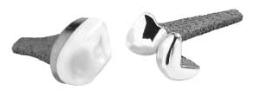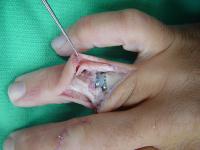| Small joint arthoplasty has been an
ongoing problem of hand surgery. The delicate and anatomically precise
joints of the fingers function within a very narrow tolerance of friction
and mechanical balance of bone and soft tissue forces. Historically, flexible
(silicone rubber) implants have failed because of implant breakage, erosive
reaction to implant wear debris, and inability of flexible implants to
provide rotational and lateral stability.
Surface replacement implant arthroplasty of the finger joints, similar
to large joint replacement, appears to be an improvement on previous strategies,
as it mimics the normal joint mechanics, stability, and durability.
The implant used in this case is produced by Avanta (www.avanta.org),
constructed of titanium and polyethylene surfaces:

|






